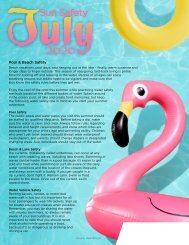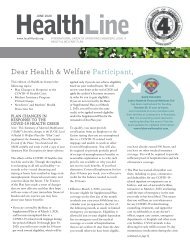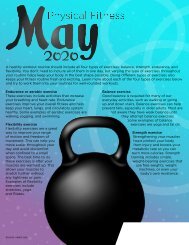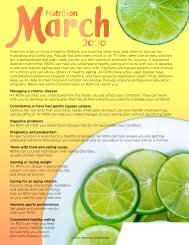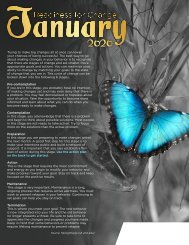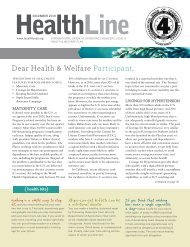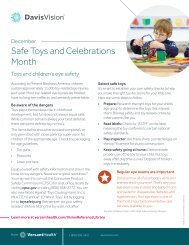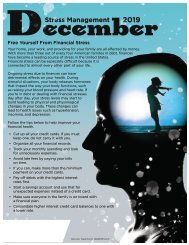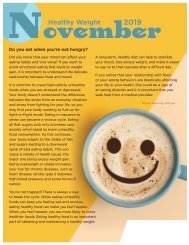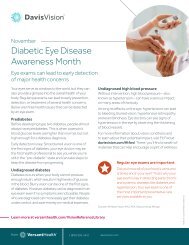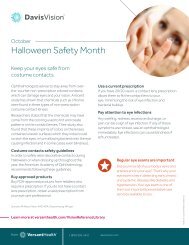August 2018
You also want an ePaper? Increase the reach of your titles
YUMPU automatically turns print PDFs into web optimized ePapers that Google loves.
HealthLine<br />
AUGUST <strong>2018</strong><br />
www.local4funds.org<br />
INTERNATIONAL UNION OF OPERATING ENGINEERS LOCAL 4<br />
HEALTH & WELFARE PLAN<br />
Dear Health & Welfare<br />
Participant,<br />
THIS EDITION OF HEALTHLINE<br />
FEATURES THE FOLLOWING TOPICS:<br />
• Update on the Livongo for<br />
Diabetes Program<br />
• Wellness Initiative Update<br />
• Your Benefits: 3–D Mammograms<br />
• Keep Us Updated<br />
• Grandfathered Health Plan<br />
UPDATE ON LIVONGO<br />
FOR DIABETES PROGRAM<br />
During June, the Board of Trustees<br />
announced a new approach to diabetes<br />
management. Effective July 1, members<br />
with type 1 and type 2 diabetes are<br />
able to join the Livongo for Diabetes<br />
Program (“Livongo”), a health benefit<br />
that makes living with diabetes easier by<br />
providing members with a connected<br />
meter, unlimited strips, and coaching.<br />
The program is offered at no cost<br />
to covered members and dependents,<br />
ages 18 and older. Coaches provide<br />
one-on-one support by phone, email,<br />
text or mobile app to help members<br />
with questions about nutrition or<br />
lifestyle changes. With each check of<br />
blood glucose using the Livongo meter,<br />
members receive a personalized message<br />
to help them make informed choices<br />
about their health.<br />
Want to learn more or enroll? It’s<br />
as simple as visiting www.welcome.<br />
livongo.com/LOCAL4 or calling<br />
1-800-945-4355. When enrolling,<br />
don’t forget to use the Plan’s registration<br />
code: LOCAL4. Those who enroll will<br />
also be eligible for a monetary incentive<br />
from Livongo, so sign up today!<br />
UPDATE ON <strong>2018</strong><br />
WELLNESS INITIATIVE<br />
The <strong>2018</strong> Wellness Program is in full<br />
swing. Since January, members and<br />
dependents have been taking advantage<br />
of the various challenges. Fifty-four<br />
members enrolled in the Spring Steps<br />
Challenge and netted 24,801,742<br />
steps over a six-week period. The two<br />
members who achieved the highest<br />
(health bits)<br />
To be your best at work,<br />
you need to be well-rested.<br />
Improve your sleep hygiene through<br />
these simple steps: Go to bed and<br />
get up at the same time each day.<br />
Keep your bedroom dark, quiet, and<br />
cool. Avoid eating large meals before<br />
bedtime. And don’t use your phone,<br />
tablet, or computer in bed.<br />
average number of steps at the end of<br />
the challenge won Apple Watches. Of<br />
those enrolled in the challenge, 39%<br />
met their goal to walk an average of<br />
7,000 steps a day and entered a raffle<br />
to win one of ten $100 gift cards.<br />
If you missed the first challenges,<br />
it’s not too late to get started! Visit<br />
www.ahealthyme.com/login and<br />
click on “Click here to sign up” to<br />
register. If you have your annual<br />
wellness visit or any dental cleanings<br />
between January and October 15, each<br />
visit will qualify you for entry into a<br />
raffle to win one of ten $50 gift cards,<br />
redeemable at most major retailers.<br />
Further, if you are 35 or older and<br />
get a mammogram, or 50 or older and<br />
get a colonoscopy by October 15, you<br />
will be entered into a separate raffle to<br />
win one of ten $50 gift cards.<br />
For those who have been trying<br />
to quit smoking but have trouble<br />
going it alone, sign up for the “Breathe<br />
(continued on page 8)<br />
Want to lower your risk<br />
for diabetes? Get enough<br />
vitamin D. A recent long-term<br />
study in the journal PLOS ONE<br />
found that men with healthy levels<br />
of vitamin D had only one-third the<br />
incidence of diabetes. Your body<br />
produces vitamin D naturally when<br />
your skin is exposed to the sun.
2<br />
During<br />
Menopause<br />
TRY TO AVOID THESE FOODS<br />
(recipe)<br />
Naturally Sweet<br />
Lemonade<br />
2 large apples<br />
½ lemon<br />
1½ cups sparkling water (optional)<br />
IF YOU’RE A WOMAN GOING<br />
THROUGH MENOPAUSE, you’re probably<br />
already familiar with some of the<br />
symptoms this time of life can produce.<br />
From hot flashes to mood swings to<br />
trouble sleeping and even difficulty concentrating,<br />
you may experience a variety<br />
of challenging physical and emotional<br />
changes over a period of years. Getting<br />
regular exercise, eating a nutritious diet,<br />
and making sleep a priority may help<br />
reduce symptoms. You may also find that<br />
yoga or meditation helps.<br />
Hot flashes are the most common<br />
symptom of menopause, and certain<br />
foods can trigger them, including:<br />
• Spicy foods<br />
• Alcoholic beverages<br />
• Foods and drinks that contain caffeine.<br />
In addition to coffee and tea, some<br />
other foods can contain caffeine, including<br />
chocolate and ice cream. Some pain<br />
relievers also contain caffeine, so check<br />
the label of any medicine you take.<br />
Slice apples and lemons small enough<br />
to fit into a juicer. Juice apples and<br />
lemon. Whisk together to make sure<br />
they are well-blended. Divide among<br />
three glasses. If using sparkling water,<br />
pour it into the glasses, then stir.<br />
Serves three. Serving size is ½ cup.<br />
Each serving contains about 70<br />
calories, 0 g fat (0 g saturated fat, 0<br />
g trans fat), 0 mg cholesterol, 3 mg<br />
sodium, 23 g carbohydrates, 15 g<br />
sugar, 4 g fiber, and 0.5 g protein.<br />
(test your savvy on … childhood obesity)<br />
1. Over the past four decades,<br />
the childhood obesity rate<br />
has more than doubled.<br />
True False<br />
2. Type 2 diabetes, previously<br />
seen mostly in adults,<br />
is increasingly common<br />
among children. Experts<br />
believe childhood obesity is<br />
the cause.<br />
True False<br />
3. The U.S. Preventive Services<br />
Task Force (USPSTF)<br />
recommends doctors<br />
conduct obesity screenings<br />
for children and teens ages 6<br />
and older.<br />
True False<br />
4. To help your child manage<br />
his or her weight, focus on<br />
providing nutritious meals<br />
and snacks and teaching<br />
healthy food choices.<br />
True False<br />
ANSWERS: 1. False. The childhood obesity rate has more than tripled. 2. True. Your child is considered obese if he or she has a body mass index in the<br />
95th percentile or higher. 3. True. The USPSTF also notes that doctors should offer behavioral interventions as necessary. 4. True. For example, limit<br />
soda and sugary fruit drinks and provide skim milk or water instead.
1Strength training<br />
2Strength train-<br />
3Strength training<br />
4Strength training<br />
4REASONS WHY YOU NEED TO<br />
3<br />
STRENGTH TRAIN<br />
Strength training is an important component to a quality<br />
exercise program. Here are four reasons you need to<br />
strength train.<br />
can reduce your<br />
ing can help you<br />
can improve your<br />
can make every-<br />
risk for diabetes<br />
maintain your<br />
balance, protect-<br />
day things easier,<br />
and heart disease.<br />
joint flexibility.<br />
ing you from falls<br />
such as carrying<br />
Plus, more muscle<br />
and injuries. Aim<br />
groceries.<br />
mass helps your<br />
to perform exer-<br />
body burn calories<br />
cises that hone<br />
faster, making it<br />
in on your lower<br />
easier to control<br />
body to get this<br />
your weight.<br />
benefit.<br />
The best part is fancy gym equipment is not required to perform strength<br />
training exercises. That’s because there are a variety of strengthening moves<br />
you can do that use your body for resistance. Here are some to try:<br />
Try: Abdominal crunches<br />
Why: They can strengthen your core<br />
muscles, which include your pelvis, lower<br />
back, hips, and abdomen. These muscles<br />
work together to keep your body balanced<br />
and stable.<br />
Try: Push-ups on<br />
the floor or against<br />
a wall<br />
Why: Push-ups strengthen your<br />
chest, shoulders, arms, and core.<br />
How much strength training do you need?<br />
2 to 3<br />
sessions<br />
per week<br />
20 to 30<br />
minutes per<br />
session<br />
TAKE YOUR<br />
TRAINING OUTSIDE<br />
You don’t need to stay indoors<br />
to reap the rewards of strength<br />
training. Find a nearby park<br />
at www.nps.gov and practice<br />
stepping up onto a bench, walk<br />
uphill trails that will strengthen<br />
your leg muscles and joints, or<br />
perform push-ups in the grass.
4<br />
SHOULD YOU START<br />
Getting Mammograms Earlier?<br />
SCREENING MAMMOGRAMS ARE<br />
BREAST X-RAYS THAT CAN DETECT<br />
BREAST CANCER BEFORE IT CAUSES<br />
SYMPTOMS. Experts agree that mammograms<br />
save lives. But there’s a difference<br />
of opinion about the best age to<br />
start getting them. In guidelines from<br />
different groups within the past few years,<br />
the recommended starting age varies<br />
from 40 to 50. So when should you get a<br />
mammogram?<br />
BALANCING BENEFITS AND RISKS<br />
Mammograms reduce deaths from breast<br />
cancer. That’s a huge benefit. Yet women<br />
ages 50 and older have the most to gain.<br />
For those ages 40 to 49, the number of<br />
deaths prevented is smaller.<br />
Mammograms have risks as well.<br />
They sometimes produce false positives—<br />
results that appear abnormal when no<br />
cancer is present. False positives can cause<br />
anxiety and lead to more testing.<br />
Another risk is overdiagnosis—finding<br />
and treating noninvasive breast cancer<br />
that never would have caused problems.<br />
This isn’t harmless because unnecessary<br />
treatment has risks of its own.<br />
WHAT THE EXPERTS RECOMMEND<br />
The American Cancer Society says that<br />
screening mammograms should be an<br />
option starting at age 40, and all women<br />
should be getting them by age 45. The<br />
U.S. Preventive Services Task Force,<br />
on the other hand, says that all women<br />
should start mammograms by age 50.<br />
See page 8 of this HealthLine for<br />
information about how you can receive<br />
3–D mammograms annually beginning<br />
at age 35.<br />
LEARN MORE<br />
ABOUT<br />
MAMMOGRAMS<br />
For a video overview, go<br />
to www.radiologyinfo.org.<br />
Search for “your radiologist<br />
explains mammography.”<br />
WE HEAR OFTEN ABOUT THE MANY<br />
HEALTH BENEFITS OF FRUITS<br />
AND VEGETABLES.<br />
But did you know that eating them can<br />
also make you happier and more<br />
satisfied with life? An Australian<br />
study found that people who<br />
increased their fruit and veggie<br />
consumption gained a greater sense<br />
of well-being and happiness.<br />
(health bits)<br />
Atrial fibrillation affects<br />
about 10 percent of people<br />
older than age 65. The easiest<br />
way to detect it? A simple pulse check<br />
performed at rest and before and after<br />
activities. If it’s outside the normal<br />
range (60 to 100 bpm) and you feel<br />
unwell, or if it feels irregular or “jumpy,”<br />
talk with your doctor.
5<br />
WHY DOES<br />
My Hip Hurt?<br />
IF YOU ARE A WOMAN WITH HIP PAIN, FIGURING OUT THE CAUSE IS KEY<br />
TO GETTING THE RIGHT TREATMENT. Here are three common causes of hip<br />
pain in women.<br />
OSTEOARTHRITIS<br />
Osteoarthritis is a common condition that many women develop in middle<br />
age. As cartilage wears away, bones rub together, causing pain, stiffness, and<br />
decreased range of motion. The condition develops slowly over time. Your<br />
risk is higher if you had a previous hip injury, are obese, have a family history<br />
of osteoarthritis, or are over the age of 50.<br />
BURSITIS<br />
Between the bones and soft tissues of your joints there are jellylike sacs<br />
called bursae that act like pillows to reduce friction. Your hip bone has<br />
two major ones—one in the groin area and another at the bony point of<br />
your hip. When a bursa becomes inflamed, it’s called bursitis. The pain<br />
may be sharp and intense at first and then become more of an ache. It is<br />
more common in women and middle-aged and older adults.<br />
HIP FRACTURE<br />
If you fell or experienced a direct blow to your<br />
hip, you may have a hip fracture, a break in<br />
your upper thigh bone. You may feel pain<br />
NEED SURGERY?<br />
in the upper thigh or groin area that gets Could you be a candidate for<br />
worse when you try to rotate your hip.<br />
a total hip replacement? Learn<br />
Women have a higher risk for hip fracture more about this procedure by<br />
than men, especially women who have<br />
watching a video. Go to www.<br />
osteoporosis or cancer.<br />
orthoinfo.aaos.org and search<br />
for “total hip replacement<br />
If you have hip pain, be sure to see your doctor.<br />
He or she will examine you and may ask<br />
procedure.”<br />
for additional tests such as an X-ray, a bone scan,<br />
or an MRI to diagnose what’s causing your pain. The<br />
right treatment approach will help you get the best pain relief.<br />
Low back pain got you<br />
down? You might want to try yoga.<br />
Researchers looked at 12 studies of<br />
more than 1,000 men and women<br />
with nonspecific low back pain and<br />
found that yoga classes improved<br />
back function and reduced symptoms<br />
of low back pain more effectively<br />
than no exercise.<br />
LOOKING TO INCREASE<br />
THE AMOUNT OF<br />
WHOLE GRAINS<br />
YOU EAT? Get a little creative.<br />
Instead of breading, try ground rolled<br />
oats or crush some unsweetened wholegrain<br />
cereal as a coating for chicken<br />
or fish. Popcorn without added salt or<br />
butter also counts as a whole grain.
6<br />
WAYS TO<br />
LOWER YOUR A1c<br />
If you have diabetes, you’ve probably heard<br />
about the A1c test. This blood test assesses your average blood<br />
sugar level over the previous three months. It’s important to know how well your<br />
blood sugar is controlled over time. In the long term, high blood sugar can harm your<br />
heart, blood vessels, kidneys, feet, and eyes.<br />
A1c results are written as a percentage. For many people with diabetes, the goal<br />
is to keep that percentage below 7. But some people have a different goal. Ask your<br />
doctor what’s right for you.<br />
So what should you do if your A1c number is too high? These steps can help lower<br />
your A1c level and reduce your risk for long-term health problems.<br />
1 2 3 4 5<br />
Be more active every<br />
day. Aim for at least<br />
150 minutes per week<br />
of moderate-intensity<br />
activity, such as walking<br />
briskly, cycling, swimming,<br />
and dancing. Ask your<br />
doctor for advice on safe,<br />
effective exercise.<br />
Follow a diabetes<br />
meal plan. Emphasize<br />
fruits, vegetables,<br />
whole grains, beans,<br />
fish, skinless poultry,<br />
lean meats, and<br />
nonfat or low-fat dairy<br />
products. Work with<br />
your health care team to<br />
create your eating plan.<br />
Address your stress<br />
level. Too much stress<br />
can raise blood sugar<br />
levels. When you’re<br />
feeling pressured or<br />
overwhelmed, try<br />
taking deep breaths,<br />
meditating, going for<br />
a walk, or listening to<br />
soothing music.<br />
Take diabetes<br />
medication, if your<br />
doctor prescribes<br />
it. Keep taking your<br />
medicine as directed<br />
even when you’re<br />
feeling fine.<br />
Check your blood<br />
sugar at home,<br />
if your doctor<br />
recommends it.<br />
This lets you track<br />
shorter-term blood<br />
sugar changes.<br />
One final reminder: Don’t forget to schedule your next A1c test. Most people with<br />
diabetes should have the test at least twice per year. If your last A1c number was too<br />
high, however, your doctor may recommend more frequent testing. It’s a great way<br />
to gauge the progress you are making toward better diabetes control.<br />
DISH UP<br />
BETTER<br />
EATING HABITS<br />
Practice making healthy<br />
food choices with an<br />
interactive tool. Go to<br />
www.diabetes.org and<br />
search for “create<br />
your plate.”
7<br />
Love to<br />
Tan?<br />
YOU BEDDER BELIEVE YOU NEED<br />
A SKIN CANCER CHECK<br />
USING A TANNING BED—AND<br />
THE INTENSE ULTRAVIOLET (UV)<br />
RADIATION you’re exposed to while<br />
tanning—puts you at a higher risk for<br />
skin cancer, including melanoma, the<br />
deadliest form, compared with people<br />
who don’t tan indoors.<br />
Getting your skin checked regularly by<br />
your doctor or a dermatologist can help<br />
spot skin cancer in its early, most treatable<br />
stages. In fact, tanning bed manufacturers<br />
have to post this statement on their<br />
devices: “Warning: Persons repeatedly<br />
exposed to UV radiation should be regularly<br />
evaluated for skin cancer.”<br />
IF YOU TAN, GET CHECKED<br />
A recent study in JAMA Dermatology,<br />
however, found that only about 30 percent<br />
of the almost 5,000 indoor tanners<br />
surveyed have ever received a full-body<br />
skin cancer exam by a physician.<br />
A skin cancer check is simple. During<br />
the exam, a doctor or nurse will look at<br />
your skin from head to toe for unusual<br />
moles or other colored areas. If anything<br />
appears abnormal, the doctor will remove<br />
some of the questionable tissue to check<br />
for cancer cells in the lab.<br />
Being proactive can pay off. Melanoma<br />
is easier to cure if it’s found before<br />
it spreads to other parts of the body.<br />
BE ON THE LOOKOUT<br />
Almost 5 million people are<br />
diagnosed with skin cancer<br />
every year. To catch skin<br />
cancer early, see your<br />
doctor or dermatologist for<br />
regular skin checks. Get<br />
to your doctor right away<br />
if you have a mole that fits<br />
any one of the ABCDE<br />
criteria, which are the most<br />
concerning signs of a mole.<br />
Asymmetrical. Half of a mole or<br />
A: birthmark is shaped differently<br />
than the other half.<br />
The mole has borders that are<br />
B: blurred, jagged, or notched.<br />
Uneven color, including shades of<br />
C: brown, black, pink, or blue.<br />
Diameter—the mole is larger than a<br />
D: pencil eraser.<br />
Evolving over time—changing in<br />
shape, color, or size.<br />
E:<br />
Save your skin and yourself<br />
by avoiding tanning<br />
QUIZ TIME indoors and outdoors,<br />
Are you at risk for sun using sunscreen daily<br />
damage and skin cancer? with a sun protection<br />
Take a quiz at factor of 15 or<br />
www.skincancer.org. greater, and staying in<br />
Click on “Prevention,” the shade.<br />
then “Are You at Risk?”<br />
(health bits)<br />
Only 20 percent of ovarian cancers<br />
are found at an early stage. Awareness<br />
of the early signs and symptoms of ovarian cancer<br />
improves the odds of effective treatment. These may<br />
include: feeling the need to urinate often or urgently,<br />
abdominal or pelvic pain, feeling full quickly or having<br />
trouble eating, and bloating. If you have symptoms like<br />
these on a near-daily basis for more than a few weeks,<br />
talk with your doctor.<br />
WANT TO PREVENT<br />
PROSTATE<br />
CANCER? Focus on<br />
maintaining a healthy weight, says<br />
the Prostate Cancer Foundation.<br />
And eat more fish—several studies<br />
suggest lots of omega-3 fatty acids<br />
can help protect your prostate.
IUOE Local 4 Health & Welfare Plan<br />
PO Box 660<br />
Medway, MA 02053-0660<br />
PRSRT STD<br />
U.S. POSTAGE<br />
PAID<br />
LONG PRAIRIE, MN<br />
PERMIT NO. 372<br />
www.local4funds.org<br />
6272M<br />
When it comes to obesity,<br />
what you’re cooking is<br />
obviously important, but so is<br />
what you’re cooking on. Chemicals<br />
found in nonstick cookware are<br />
associated with weight gain,<br />
especially in women, according to<br />
a recent study in the journal PLOS<br />
Medicine. Researchers think these<br />
chemicals, called perfluoroalkyl<br />
substances, slow the body’s<br />
metabolism.<br />
(health bits)<br />
Just because a nutritional<br />
supplement is labeled as<br />
“natural” doesn’t mean it’s safe<br />
or promotes good health. Check<br />
with your health care provider to<br />
find out about possible issues—from<br />
interactions with prescription drugs<br />
to dangers for people with certain<br />
medical conditions.<br />
Feeling stressed? Instead<br />
of turning to destructive coping<br />
mechanisms, like drugs or alcohol,<br />
talk about your problems with<br />
whomever you can: family, friends,<br />
or a doctor, counselor, or clergy<br />
member. Connecting with someone<br />
who cares can help you cope with<br />
stress in a healthier way.<br />
If you think you are an<br />
expert multitasker, try tracking<br />
your time for just one workday. You<br />
might be surprised to find out how<br />
often you get sidetracked. Combining<br />
like tasks that require similar skills and<br />
then dedicating a set time to complete<br />
them might prove to be a more<br />
effective approach.<br />
(continued from page 1)<br />
Easy” smoking-cessation online workshop<br />
during <strong>August</strong> and September at www.<br />
ahealthyme.com/login. You will receive<br />
support and guidance to quit, and be entered<br />
into a raffle to win one of ten $50 gift cards.<br />
If you have questions about these wellness<br />
initiatives, please call the Plan’s Eligibility<br />
Department at 1-888-486-3524 (option 5).<br />
OUR BENEFITS:<br />
3–D MAMMOGRAMS<br />
The Plan now covers 3–D mammograms<br />
(digital breast tomosynthesis) at no cost to<br />
you, just as with standard mammograms<br />
annually after age 35. Regular screenings<br />
are the best way to find breast cancer at<br />
an early stage, when treating the disease<br />
has the highest success rates. Talk to your<br />
doctor about the benefits and timing of<br />
your mammogram screenings.<br />
KEEP US UPDATED<br />
Let us know if you’ve moved or changed<br />
your phone number or other contact<br />
information so we may update our records<br />
and keep you in the loop on your great<br />
benefits! The Plan sends important mailings<br />
throughout the year. It is vital that your<br />
contact and dependent info is current.<br />
Submit any changes in writing to the<br />
Benefit Funds Office. You may download<br />
a change of address form from our website<br />
at www.local4funds.org and mail it<br />
to: IUOE Local 4 Benefit Funds, P.O.<br />
Box 660, Medway, MA 02053.<br />
If you have recently gotten married<br />
or divorced or welcomed a child into your<br />
family, please ensure you have completed<br />
a new census card as well.<br />
Also, if you have not yet submitted<br />
your email address to us, please consider<br />
going online at www.local4funds.org<br />
to do so. You will continue to receive all<br />
Plan communications via mail for the time<br />
being, but it will provide us with another<br />
way to reach out and stay in touch!<br />
GRANDFATHERED<br />
HEALTH PLAN<br />
Please note that this Plan is a “grandfathered<br />
health plan” under the Affordable Care Act.<br />
For more information, please refer to page v<br />
of your Summary Plan Description, or page<br />
vii of the online version.<br />
Sincerely,<br />
Your Board of Trustees<br />
William D. McLaughlin, Chairman<br />
Nino Catalano<br />
Paul C. DiMinico<br />
David F. Fantini<br />
James Reger<br />
John J. Shaughnessy, Jr.<br />
IUOE Local 4<br />
William D. McLaughlin, Business Manager<br />
Administrator<br />
Gina M. Alongi<br />
Information in the publication is the opinion of the authors. Personal decisions regarding health, finance, exercise, and other matters should be made after<br />
consultation with the reader’s professional advisors. All models used for illustrative purposes only. All editorial rights reserved. Developed by StayWell.



